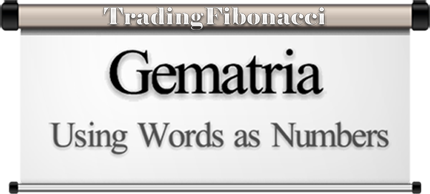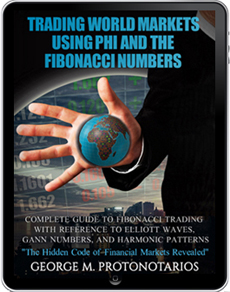
Decoding Markets: Key Mathematical Figures Shaping Global Finance
Mathematical constants like phi (φ) and pi (π) play a crucial role in finance due to their distinctive structural characteristics. The golden ratio (φ ≈ 1.618) represents natural growth patterns and proportional balance, making it a valuable tool for uncovering repetitive motifs in market trends and technical analysis. On the other hand, pi (π ≈ 3.14159), fundamental to circular and harmonic motion, serves as a cornerstone for modeling cyclical movements in asset prices, interest rates, and broader economic cycles. Mastery of these constants provides investors with enhanced analytical perspectives to better understand market behavior and develop sophisticated quantitative strategies.
☑ Fibonacci Sequence of Numbers and Phi
The Fibonacci sequence is highly significant in stock investing and is closely linked to the Golden Ratio. The name "Fibonacci sequence" was first introduced in the 19th century by Édouard Lucas, although the history of the sequence dates back centuries before the time of Christ. Each number in the sequence is derived by adding the two preceding numbers, following the rule: X(n) = X(n-1) + X(n-2).
Here are the first numbers…
|
1 |
2 |
3 |
5 |
8 |
13 |
21 |
34 |
55 |
89 |
144 |
233 |
377 |
610 |
987 |
1,597 |
2,584 |
4,181 |
6,765 |
The Golden Ratio (Phi or Φ): 1.618 {1.61803398874989484820..}
The Golden Ratio is a number found throughout nature and the universe. In technical analysis, it is widely used to help determine whether a financial market is likely to continue its trend or reverse.
» Fibonacci Sequence and Phi | » The Fibonacci eBook at Amazon (ePub) | » The Fibonacci ebook in .PDF
☑ The Prime Numbers
Prime numbers are natural numbers that cannot be formed by multiplying two smaller natural numbers.
- Prime numbers have only 2 factors: 1 and themselves.
First rime numbers:
- 1, 2, 3, 5, 7, 11, 13, 17, 19, 23, 29, 31, 37, 41, 43, 47, 53, 59, 61, 67, 71, 73, 79, 83, 89, 97….
Key Characteristics of Prime Numbers
1. Building Blocks of Integers (Fundamental Theorem of Arithmetic)
Every natural number greater than 1 is either a prime or can be uniquely expressed as a product of prime numbers (apart from the order of the factors). In this sense, prime numbers are the "atomic units" of the number system.
Example: 12 = 2 × 2 × 3 = 2² × 3
This prime factorization is unique—no other combination of primes will yield 12.
2. Infinitely Many Primes
The set of prime numbers never ends. This was first proven by the Greek mathematician Euclid around 300 BCE.
Proof Idea: Suppose there are only finitely many primes. Multiply them all together and add 1. The result cannot be divisible by any of those primes (it leaves a remainder of 1). Hence, the number is either prime or has a new prime factor—not in the original list. This contradiction proves that primes are infinite.
3. Prime Distribution
Primes become less frequent as numbers grow, but they never disappear.
Importance and Applications
-
Number Theory: Primes are essential for understanding divisibility, greatest common divisors (GCD), and modular arithmetic.
-
Cryptography: Many modern systems (like RSA encryption) rely on the difficulty of factoring large composite numbers into primes.
-
Unsolved Problems: Primes are at the heart of famous conjectures
» Read more on TradingCenter.org
☑ Archimedes Constant (Pi or π): 3.14 {3.1415926535..}
Archimedes constant is the name given to the ratio of the circumference of a circle to the diameter. Pi is the key constant in any equation that involves circular or harmonic motion.
Calculation:
Archimedes' constant (π) is defined as the ratio of a circle's circumference (C) to its diameter (d):
- π = C / d
Archimedes' Pioneering Work (3rd Century BCE)
Although Archimedes wasn’t the first to explore π, he was the first to systematically approximate its value with mathematical rigor.
-
He used inscribed and circumscribed regular polygons (up to 96 sides) around a circle to estimate the value of π.
-
From his calculations, he showed: 3.1408 < π <3.1429
-
This approach, known as the method of exhaustion, was a precursor to modern integral calculus.
Origin of the Symbol π
The Greek letter π (pi) was popularized by mathematician Leonhard Euler in 1737.
-
The symbol comes from the Greek words περιφέρεια (periphery) or περίμετρος (perimeter)
☑ Euler's Number (e): 2.7182
Euler's number, also known as the exponential growth constant, is the base of natural logarithms. In finance, it plays a crucial role and is used to calculate compound interest.
Euler’s number, denoted as e, is one of the most important constants in mathematics, approximately equal to 2.71828. Unlike simple decimals, e is an irrational number — its decimal expansion goes on infinitely without repeating.
This remarkable constant forms the foundation of:
-
Exponential growth and decay models (e.g., population growth, radioactive decay)
-
Calculus, especially in defining natural logarithms and derivatives of exponential functions
-
Complex analysis, where it links exponential functions with trigonometry through Euler’s formula
☑ The Black–Scholes Model & The 'Greeks'
This model was developed by Fischer Black and Myron Scholes, and later expanded by Robert Merton. Black and Scholes were awarded the Nobel Prize in Economics in 1997 for their discovery. This single equation played a key role in the creation of the global derivatives market.
-
Robert C. Merton and Myron Scholes were awarded the Nobel Prize (1997) in Economics for their groundbreaking work.
-
The model provided a reliable framework for pricing options, sparking explosive growth in global derivatives markets.
-
Laid the cornerstone for financial engineering and quantitative trading strategies.
Calculation
The Black-Scholes formula calculates the theoretical price of a call or put option:
Call Option Price (CC): C=S0N(d1)−Xe−rTN(d2)C=S0N(d1)−Xe−rTN(d2)
Put Option Price (PP): P=Xe−rTN(−d2)−S0N(−d1)P=Xe−rTN(−d2)−S0N(−d1)
Where:
S0S0 = Current asset price
XX = Strike price
TT = Time to expiration (years)
rr = Risk-free interest rate
N(⋅)N(⋅) = Cumulative distribution function (CDF) of the standard normal distribution
d1=ln(S0/X)+(r+σ2/2)TσTd1=σTln(S0/X)+(r+σ2/2)T
d2=d1−σTd2=d1−σT
σσ = Volatility (annualized standard deviation of returns)
The 'Greeks'
The “Greeks” are key risk indicators in options trading that measure how an option’s price reacts to shifts in market variables such as the underlying asset price, volatility, and time decay. These metrics stem from the partial derivatives of the Black-Scholes model and play a crucial role in hedging, managing risk, and crafting effective trading strategies.
Why Traders Rely on the Greeks
Hedging:
-
Construct delta-neutral positions to minimize exposure to small price fluctuations.
-
Monitor gamma to determine when and how often to rebalance hedges.
Volatility Trading:
-
Holding long vega positions by buying straddles or strangles to profit from rising implied volatility.
-
Taking short vega positions by selling options to benefit from expected volatility declines.
Time Decay Strategies:
-
Selling options with high theta, such as credit spreads, to capitalize on the gradual loss of option value over time.
Risk Exposure Assessment:
-
Detect “pin risk” caused by elevated gamma near option expiration.
-
Measure interest rate sensitivity (rho) especially for options with longer maturities.
Primary 'Greeks'
Below is an overview of the primary 'Greeks':
Table: Traders utilize derivatives of the Black-Scholes-Merton (BSM) model to assess how sensitive option prices are to various factors:
| Greek | Meaning | Primary Application | Mathematical Expression (Call Option) |
|
Sensitivity of option price to underlying asset price | Hedging price exposure |
|
|
Rate of change of Delta with respect to underlying price | Adjusting hedge frequency |
|
|
Sensitivity of option price to volatility changes | Speculating on volatility shifts |
|
|
Time decay: rate of option price change as expiration nears | Managing value erosion over time |
|
|
Sensitivity of option price to interest rate changes | Exposure to interest rate fluctuations |
|
☑ Gematria & Ancient Greek Numbers

Gematria is an ancient Kabbalistic method (Qabalah) of interpreting Scriptures by substituting words whose letters share the same numerical value when added together.
- Gematria derives from the Greek word Geometria, which means Geometry (Geo meaning earth and metria meaning measurement).
- This method held great significance in antiquity, particularly in Classical Greece and Judaism. It appears that the Greeks developed the method, while the Jews refined and optimized it.
Implementing Gematria in Modern Languages
Greek and Hebrew are the only two languages in which gematria can be fully applied as a method of interpreting words as numbers. In theory, any language—including English—can be used similarly.
Greek Alphabet Numerical Values
Below is a table showing the numerical value assigned to each Greek letter.
|
Greek Letter |
Value |
|
Α α |
1 |
|
Β β |
2 |
|
Γ γ |
3 |
|
Δ δ |
4 |
|
Ε ε |
5 |
|
(ς' |
6 |
|
Ζ ζ |
7 |
|
Η η |
8 |
|
Θ θ |
9 |
|
Ι ι |
10 |
|
Κ κ |
20 |
|
Λ λ |
30 |
|
Μ μ |
40 |
|
Ν ν |
50 |
|
Ξ ξ |
60 |
|
Ο ο |
70 |
|
Π π |
80 |
|
Ρ ρ |
100 |
|
Σ σ ς |
200 |
|
Τ τ |
300 |
|
Υ υ |
400 |
|
Φ φ |
500 |
|
Χ χ |
600 |
|
Ψ ψ |
700 |
|
Ω ω |
800 |
Hebrew Letters Numerical Values
Here is a table with the value of each Hebrew Letter
|
Decimal |
Hebrew |
Glyph |
|
1 |
Aleph |
א |
|
2 |
Bet |
ב |
|
3 |
Gimel |
ג |
|
4 |
Daled |
ד |
|
5 |
He |
ה |
|
6 |
Vav |
ו |
|
7 |
Zayin |
ז |
|
8 |
Het |
ח |
|
9 |
Teth |
ט |
|
10 |
Yud |
י |
|
20 |
Kaph |
כ |
|
30 |
Lamed |
ל |
|
40 |
Mem |
מ |
|
50 |
Nun |
נ |
|
60 |
Samech |
ס |
|
70 |
Ayin |
ע |
|
80 |
Pe |
פ |
|
90 |
Tsade |
צ |
|
100 |
Qoph |
ק |
|
200 |
Reish |
ר |
|
300 |
Shin |
ש |
|
400 |
Taw |
ת |
|
500 |
Kaph |
ך |
|
600 |
Mem |
ם |
|
700 |
Nun |
ן |
|
800 |
Pe |
ף |
|
900 |
Tsade |
ץ |
In Hebrew, some popular numerical values include:
1) GOD, IHVH, numerical value = 26 (10+5+6+5)
2) Man, (Adam), the numerical value of 45
3) The difference between God and Man is 19 (45-26)
4) The same value of 19 can be found by interpreting the word EVE (ChVH). That means that God = Man-Woman
Derivative Numerical Values
1) 2,701: 26 squared (676) plus 45 squared (2025)
2) 163 (the circumference of the circle created within)
» More about Gematria at Wikipedia
■ Important Numbers for Investors & Gematria
TradingFibonacci.com
▶️ FIND OUT MORE AT TRADINGFIBONACCI.COM











